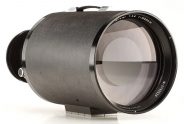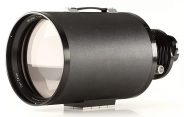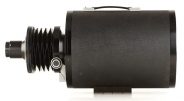Carl Zeiss Mirotar 1000mm F/5.6
Super telephoto prime lens • Film era • Discontinued
- Announced:
- · 1974
- Production status:
- ● Discontinued
- Country of design:
- · FRG (Federal Republic of Germany)
- Original name:
- · Carl Zeiss Mirotar 1:5,6 f=1000mm
- Class:
- · Slow 6x6 medium-format super telephoto prime lens
- · Professional model (Top class)
- · Mirror/Reflex lens
- System:
- · Contax/Yashica (1974)
- · Rolleiflex SL35 (1970)
- · Rolleiflex SL66 (1966)
Model history (2)
| ■Carl Zeiss Mirotar 1000mm F/5.6 (23 units) | -- | 5 - 5 | 12.00m | -- | 1964 ● | |
| ■Carl Zeiss Mirotar 1000mm F/5.6 | -- | 5 - 5 | 12.00m | -- | 1974 ● | |
Specification
| Optical design: | |
| Medium format 6x6 | |
| 1000mm | |
| F/5.6 | |
| 5 elements in 5 groups | |
| Interchangeable mount | |
| Diaphragm mechanism: | |
Diaphragm type: | Fixed |
Aperture control: | None |
| Focusing: | |
| 12m | |
| 1:9 | |
Focusing modes: | Manual focus only |
Manual focus control: | Rack-and-pinion mechanism |
| Physical characteristics: | |
| 16500g | |
| ⌀250×420mm | |
| Accessories: | |
| Removable front filters are not accepted | |
Additional features: | Drop-in filter holder (60mm) |
| Not available | |
| Carl Zeiss Mutar T* 2X I (AE) → 2000mm F/11.2 | |
| Carl Zeiss Mutar T* 2X II (AE) → 2000mm F/11.2 |
Sources of data
- Manufacturer's technical data.
- Contax/Yashica 35mm SLR Camera System booklet (177 pages).
- Contax system accessories & lenses booklet.
- The finest optics by ZEISS: interchangeable photographic lenses with Contax/Yashica mount booklet (October 1975).
- Contax Real Time Photography booklet (PUB. CXS-GB).
- Contax Real Time System booklet (PUB. CX-28 GB).
- Contax Real Time Photography booklet (PUB. CXS2-D, in German).
- Contax Real Time System booklet (PUB. CXRTS-D, in German).
- Contax 139 Quartz booklet.
- Contax RTS III booklet.
- Contax RX booklet (June 1994).
- Contax S2 booklet.
- Yashica FX-1 instruction booklet (June 1975).
- Yashica FX-3 instruction manual.
- Contax RTS II Quartz booklet.
- Yashica/Contax Confidential Dealer Price List No. 10 (January 1980).
- Rolleiflex 3001 user's manual.
- Rolleiflex 3003 booklet (September 1984).
- Rolleiflex SL 2000 F - Practical hints handbook.
- Rolleiflex SL66 system booklet.
- Rolleiflex SL66 in practical use booklet.
- Rolleiflex SL66 user manual.
- Rolleiflex SL66 SE, Rolleiflex SL66 X booklet (August 1987).
- Rollei Fototechnic SL 2000 F system booklet (December 1983).
- Rollei Fototechnic SL 66 E / SL 66 system booklet (December 1983).
- Rolleiflex SL66SE, SL66X user's manual (June 1990).
- Contax Real Time Photography 50 Years booklet.
- Rolleiflex SL66E/SL66. The Medium-Format Leader booklet.
- Contax ST booklet (March 1994).
- Contax 167 MT booklet.
- Contax 137 MD Quartz booklet.
- Contax 137 MA Quartz booklet.
- Contax RTS II Quartz booklet (June 1984).
Manufacturer description #1
The basic design of the Mirotar® lens - concave primary mirror with a hole in the center and convex secondary mirror - is similar to the design frequently applied in astronomical telescopes. It further contains two lens elements in front of and two behind the mirror surfaces. They reduce the aberrations caused by the mirror to a minimum.
Whereas conventional lenses with a long focal length and apertures larger than f/8 exhibit disturbing chromatic aberrations, these are completely eliminated when mirrors are used. The elements employed for correction in the mirror lens are of low refractive power and are chromatically corrected so that the focus is maintained over the entire photographic spectrum. Even in IR photography, the focus is retained once it has been set visually.
The very high uniform image quality of the Mirotar®lens is due not only to the extremely good overall correction, but also to the meticulous care taken in the production of the mirror and lens systems, the mounts and in the assembly of the lens. Distant objects are imaged with keen definition in every detail. Pictures taken with the Mirotar® lens thus permit considerable subsequent enlargement. The high speed permits press and wildlife photography even under unfavorable lighting conditions.
Manufacturer description #2
A mirror lens with supreme optical correction. No focal change needed for infrared photography. Twenty times the image size compared with standard focal lengths. Recommended for long-range photography, wildlife photography and reportage photography from very great distances using a tripod. Three individual grey filters can be swung in to reduce the incident light to aperture 5.6, 8 and 11.
Manufacturer description #3
Long-range mirror lens similar to the 500mm Mirotar, of relatively high-speed and 20x magnification of the standard focal length. Recommended for the same application as the 500mm lens; three switchable neutral density filters reduce the light transmission to yield effective apertures of f/5.6, f/8 and f/11.
Manufacturer description #4
Mirror lens of same applications as the 1000mm Tele-Tessar f/8 but of twice the speed. Supreme optical correction, without focus shift with infrared shots. Extreme definition permits maximum enlargement. Users include geologists, biologists and similar professional groups who need highly precise evaluation of their pictures.
Photokina'82 report from the Popular Photography magazine (January 1983)
On the long side, Rollei announced on a made-to-order basis the exotic 500-mm Zeiss Mirotar f/4.5 and 1,000-mm f/5.6 lenses, again for the SL 2000 F. These mirror lenses could very well be the all-time status symbols for those photographers looking for same.
Typical characteristics of mirror (reflex) lenses
- Catadioptric system consisting of curved mirrors and optical glass;
- Much shorter, lighter and less expensive designs than conventional super telephoto lenses;
- Outstanding correction of chromatic aberrations;
- Since the aperture is fixed, neutral density filters are used to obtain a smaller aperture;
- Doughnut-shaped out-of-focus highlights.
From the editor
The lens was based on the Mirotar 1000mm F/5.6 lens for Contarex series 35mm SLR cameras but had interchangeable mount instead of fixed. Contax/Yashica, Rollei QBM and Rolleiflex SL66 adapters were available for this lens.
Slide type filters (IR, O, Y, UV, ND 8x) and a carrying case were part of the package. 3-position turret mount for neutral density filters could be used for adjusting the exposure.
Frequently asked questions
What does the Carl Zeiss lens designation "Mirotar" mean?
The Mirotar is a high-speed mirror lens of extra long focal length. The use of mirrors completely eliminates the chromatic aberrations so prevalent in conventional lenses of such long focal lengths. Focus is also maintained over the entire photographic spectrum, even for infrared photography. One of the major features is the compact design made possible by the doubly reversed ray path. The excellent correction of aberrations, plus the utmost precision in manufacturing the mirrors, lens elements and mounts, as well as in the assembly, guarantee uniform image quality over the entire image field. These lenses are especially notable for their extremely high speeds, considering the long focal lengths. / Source: Carl Zeiss Oberkochen literature /





